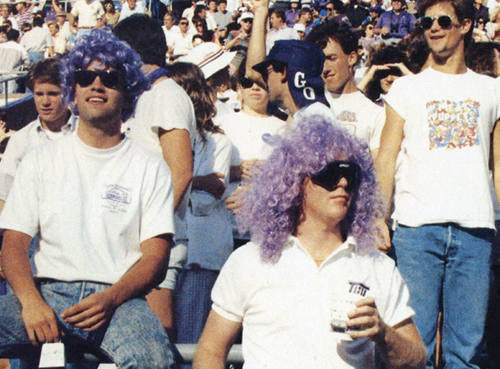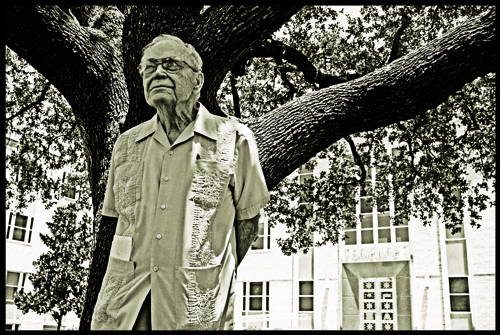|

From our readers
Good old daze
On page 60 of the fall issue of The TCU Magazine there is a picture of two guys in purple wigs. I am the one in the longer wig standing, and Robert Phillip Vaughan '69 is the one sitting.
James E. Ray II '88

Mighty Moseley
 Thank the heavens for Kathryn Hopper's terrific story about former TCU physics professor, Dr. Miller Moseley. He is one of the most wonderful and humble men I've ever met. I am thrilled beyond words that he is finally receiving the credit he deserves at your great university. Of course, I know this story inside and out because I wrote Twelve Mighty Orphans. A standing ovation to you and Kathryn for recounting his fabulous contributions to TCU and the entire world. "Mighty Mo" should never be forgotten. Thank the heavens for Kathryn Hopper's terrific story about former TCU physics professor, Dr. Miller Moseley. He is one of the most wonderful and humble men I've ever met. I am thrilled beyond words that he is finally receiving the credit he deserves at your great university. Of course, I know this story inside and out because I wrote Twelve Mighty Orphans. A standing ovation to you and Kathryn for recounting his fabulous contributions to TCU and the entire world. "Mighty Mo" should never be forgotten.
Jim Dent
My favorite rememberence of Dr. Moseley's Physics class is: He walks into the classroom and does not say a word, picks up a pencil and holds it at eye level with one hand, waves the other hand above the pencil and states "nothing above the pencil," waves his hand below the pencil and states "nothing below the pencil," then he lets go of the pencil and it drops to the floor. With a hint of a grin he mutters "gravity" -- the topic of the day.
James Kretzschmar '76
I agree strongly with the comment to the effect that respect for Dr. Moseley strongly emulated one's fear of God.
He displayed incredible mastery of his subject and did not tolerate fools, something which once bit me while taking a final exam in "vectors." In brief, if the eccentric-but-very-good doctor did not know the answer, he knew where to find it, and he often left the classroom quickly to return from his office with solid references.
Dr. Alexander A.J. Hoffman, director on my master's thesis, had the wisdom not to tell me early on that Dr. Moseley would attend the oral defense of my thesis. He and Professor Sherer (also present) were both the most expert (this side of Kansas City) in the exotic field of elliptic integrals, and Dr. Hoffman knew that if he alerted me too early to Dr. Moseley's presence, it might send my nerves into orbit. Dr. Hoffman thus told me just minutes before the exam.
As things turned out, I did perhaps my best work that day, and to my immense surprise, the Mighty Moseley was very complimentary about it.
Gordon Dobbins, '61, '63 (MA)

Christian?
While I am not a TCU alum (my wife is), I still feel it necessary to write to you in regards to an article you had in your Fall 2008 issue. The article featured a TCU alum named Kenny Thompson '03.
According to the article Mr. Thompson is currently very involved with Barack Obama's presidential campaign. Also according to the article, Mr. Thompson was actively involved with the pro-abortion group Emily's List.
It appears to me from reading the article The TCU Magazine does not have a problem with Mr. Thompson's stance on abortion. This is a grave concern.
My question to TCU is why do you continue to carry the name "Christian" in your title? In my Bible, Christ and his word clearly condemn murder (Matthew 5:21; 1 Corinthians 6:9-11). Also in my Bible it says that God hates the shedding of innocent blood (Proverbs 6:16-19). The Bible is also clear in regards to the humanity of an unborn child (Psalm 139).
It is clear that Barack Obama supports the shedding of innocent blood. It is a lot easier to call it "choice" isn't it? It is also very clear that the group known as Emily's List approves of the killing of innocent children (abortion).
I suggest you remove the name "Christian" from your university's title. The Christ I know will condemn those who practice and approve of "abortion" when He returns. You are misrepresenting Christ and His biblical standards.
Lee Wagstaff

Round tuit
As my The TCU Magazine languished on my coffee table, to be read on my next "quiet day," I got all the news I needed to hear, much to my surprise.
One of the therapists in the department where I was being treated heard me telling my therapist that I had loaned my old TCU shirt to my daughter. The therapist asked if I had seen the latest issue of The TCU Magazine, and I admitted I had not. She proceeded to fill me in on all the information I needed to know. It was so lovely to meet a fellow alumnus in San Antonio!
So, we all do read the magazine, just some of us later than others.
Sally Tarasoff '73

 Energy alternative Energy alternative
Unless I overlooked it, I saw no mention of landfill gas in the (Energy Institute) article (Fall 2008). Methane gas generated from landfills is the ultimate renewable resource. As long as the landfill is active it will continue to produce methane. The University of New Hampshire is heating and cooling five campuses with methane, and the M&M-Mars plant in Waco uses methane to fire its furnaces. Additionally, it is clean and generates significant carbon credits.
Dick Berry '68 (MBA '73)

What's in a name
Greetings from a fan, and my compliments on a fine and readable Fall 2008 issue. I'm curious about one thing, though: the Model UN blurb at the top of page 23, which used the rare and unfamiliar formal name, the Democratic People's Republic of Korea. Although your readership is highly educated and awesomely intelligent, I'll bet a dollar that not more than 10 percent realized that the DPRK is the country that we in the U.S. commonly call North Korea.
Wouldn't at least a parenthetical cross-reference have been appropriate? Did the 10 students involved not want to be associated in print with North Korea, which is not a big buddy of this country? Or was it assumed that "everybody knows that?"
Don Buckman '62

Where's the beef?
I applaud TCU for its commitment to "Bleed Purple, Live Green." However, I must challenge Lauren Geffert's assertion that adopting a vegetarian diet or reducing meat consumption can change our climate.
The production of all foods requires the expenditure of energy and greenhouse gas emissions. A study at the University of Exeter analyzed the amount of energy from fuel used in the production cycle of food. The analysis included the manufacture and application of fertilizers and chemicals, as well as harvesting, processing, packaging, transportation and waste disposal.
The study found that the most energy intensive food was coffee, requiring 177 MJ (mega-joules) of energy to produce 1 MJ of food intake. Some other samples: salad vegetables 45 MJ; fresh fruit 10-22 MJ; beef and burgers 8 MJ.
The production of methane by ruminant animal's digestion is only one-fourth of the greenhouse gases produced by all agriculture, not just livestock production. This is less than 2 percent of total greenhouse gases in the U.S.
The production of meat does not require more energy than vegetables for a comparable yield of energy. In fact, the higher nutrient density of meat protein yields more energy, higher quality protein and vitamins like B-12 only obtained from animal products as compared to lower nutrient density for vegetables and fruit.
As for methane and nitrous oxide output, the EPA estimates that ruminant digestion from animals accounted for just 1.8 percent of total greenhouse gases. All of agriculture accounts for just 7 percent of total emissions.
Jon Means, BBA '74
President, Texas and Southwestern Cattle Raisers' Assn.

 Master Planner Master Planner
In the summer of 1988, I had just finished my sophomore year and was hired at Facilities Planning to draw some buildings on a computer. I was hired because I had experience with using a mouse and the drawing program worked better with a mouse than the arrow keys.
When I finished that project, I was asked to work on a much bigger project that would entail as many hours each semester as I could give, while taking classes. That bigger project was to physically measure out the entire campus and transfer the data to create a new, more accurate and up-to-date campus plan. From the fall of 1988 to February 1990 that campus plan was my extracurricular activity. As a finance major it was great to do something outside my field and completing that campus plan was my biggest accomplishment for years -- one I'm still quite proud of because it is still in use today. Each time I see a new rendition of the campus, my original plan is the underlay. It was my drawing the 1991 Master Plan personnel used to dream their vision of what the campus could be, from what it currently was.
Hazel Rhodes Thomas '90

Non-fiction
Thank you for putting a notice in the magazine about my book, The Rebel and the Rose, but I want to clarify that this is not a novel, as the article said. It is a detailed account of $86,000 in Confederate gold coins and bullion, worth roughly $2 million today. The book focuses on Confederate Navy paymaster James Semple who was entrusted by Jefferson Davis with the gold, which was hidden in the false bottom of a carriage.
More than just an accounting of the missing treasure, The Rebel and the Rose is also the story of a man on the run, seeking to evade capture in a devastated South swarming with Federal troops. His odyssey took him from the swamps of Georgia to Canada and to the Staten Island home where met with Julia Gardiner Tyler, widow of President John Tyler, known as "The Rose of Long Island."
The book is available at major booksellers.
For information: www.rebelandtherose.com.
Jerry White '66

We welcome letters that focus on issues of concern to the University and its alumni.
Send letters to:
The TCU Magazine, TCU Box 298940,
Fort Worth, TX 76129 or tcumagazine@tcu.edu.
Limit comments to 200 words.
Letters may be edited for length or clarity. Unsigned letters will not be published. Opinions expressed are those of the signed contributors and do not necessarily represent the official position of TCU.
Comment at
tcumagazine@tcu.edu
|



